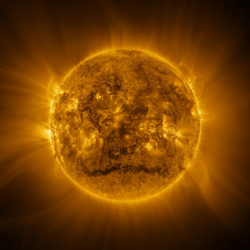IFIC makes a key contribution in an emerging field: the Sun as a source of gravitational waves
An international scientific collaboration between the Instituto de Física Corpuscular (IFIC)—a joint center of the Spanish National Research Council (CSIC) and the University of Valencia (UV)—and the Deutsches Elektronen-Synchrotron (DESY) has achieved the most detailed theoretical prediction to date of the gravitational waves generated by the Sun.
The results, recently accepted for publication in the prestigious journal Physical Review Letters, indicate that the Sun emits a continuous spectrum of high-frequency gravitational waves. These types of waves would originate from small and fast cosmic events, whereas the low-frequency gravitational waves detected so far are produced by large-scale cosmic events. Although the signal generated by the Sun is currently undetectable, it sets a well-defined benchmark for future experimental efforts.
The work developed at IFIC has been led by Camilo García Cely, a Ramón y Cajal researcher, in collaboration with Andreas Ringwald at DESY. “Our specialty is the study of dark matter, particularly axions,” García Cely explains. “However, this project led us to explore various aspects of solar physics in depth,” he adds.
Current gravitational wave detectors are designed to capture low-frequency signals, such as those generated by black hole or neutron star mergers. However, in recent years, a rapidly growing scientific community has begun focusing on the study of high-frequency gravitational waves. According to the commonly held assumption, this frequency band is free of astrophysical backgrounds, making it especially suitable for detecting signals from the early Universe. The new theoretical results challenge this assumption.
“This contribution opens up a new perspective on high-frequency gravitational waves, which had been almost entirely overlooked,” says García Cely. “We now believe that even ordinary stars like the Sun emit gravitational waves in this frequency range, at levels comparable to those expected from early-Universe processes,” he asserts.
Furthermore, as Ringwald points out, “The Sun does not emit a significant amount of gravitational radiation, but this may actually be an advantage. In fact, it leaves a wide margin for exploring new physics.” “It remains to be seen whether this radiation can be detected, but if so, it could become a powerful tool to study the Sun’s internal structure,” he emphasizes.
IFIC, under the leadership of Camilo García Cely, has played a key role in this field. His contribution is part of a national project coordinated with other groups in Spain, where he serves as the principal investigator. The predictions developed by his team are especially relevant to initiatives underway at DESY, one of the world’s leading particle physics research centers. Facilities there currently host, or will soon host, experiments such as ALPS II, BabyIAXO, MADMAX, and MAGO—all aimed at detecting axions or high-frequency gravitational waves.
This work revisits an idea first proposed in the 1960s by Steven Weinberg, one of the founding figures of particle physics. Although Weinberg estimated the total power of gravitational waves emitted by the Sun, he did not derive a detailed frequency distribution. “Our contribution has been to expand on his legacy by incorporating more physical effects and obtaining a complete and coherent spectrum of gravitational waves over a wide range of frequencies,” García Cely concludes.
Reference:
C. García-Cely and A. Ringwald, “Complete Gravitational-Wave Spectrum of the Sun”, Physical Review Letters (2025), accepted for publication.




















